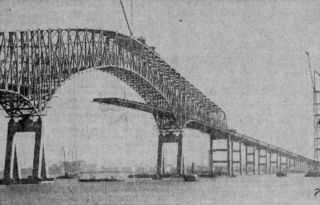Disaster Psychology
The Dangers of the Baltimore Bridge Collapse Persist
The effects of the bridge crash reach far beyond Baltimore and could be contagious.
Updated March 31, 2024 Reviewed by Devon Frye
Key points
- The Baltimore bridge collapse was tragic in and of itself, but could be psychologically contagious.
- Psychological contagion arises from incidents that are tragic, novel, and spectacular; the collapse is all.
- Interpersonal support can be an effective means of coping with incidents such as the bridge collapse.
- Allow rational thought to overcome irrational emotion.

At about 1:30 a.m. EDT on March 26, 2024, the Francis Scott Key Bridge in Baltimore experienced a catastrophic collapse. The container cargo ship Dali lost power and ran into one of the bridge’s key support pillars. Like a row of dominos, the spans which constituted the bridge collapsed. Six people are presumed dead.
While technically not a disaster, the effects of this incident reach far beyond those directly involved, far beyond the Port of Baltimore and the State of Maryland, and may even be contagious. Here’s what happened and how to protect yourself, your family, and your community.
The Incident
The Francis Scott Key Bridge was opened in 1977. It sits at the southern tip of Baltimore’s harbor. It spans about 1.6 miles and carries Interstate 695 over the Patapsco River which is the main contributary to the harbor basin. Over 30,000 vehicles crossed the bridge each day.
The 984-foot Dali is a container cargo ship that weighs over 210,000 tons when loaded. A total power failure left the ship unmaneuverable shortly after leaving the dock. Shortly after a mayday had been issued, the ship drifted into the bridge’s key support pillar. A catastrophic collapse followed.
The Adverse Physical Effects
The Port of Baltimore is the fifth busiest container port on the East Coast of the United States. The Port is completely closed which will adversely affect the commerce of the city, state, and region. The Port contributes about $15 million to the economy each day. The cost of coal, autos, and related commercial goods will likely increase as more costly transportation routes will be utilized. There will be supply chain delays. There will be longer commute times for those in the region.
The environmental impact has yet to be assessed, but no toxic chemicals are known to have been released from the ship or its cargo. Indirectly, longer commute times are likely to increase carbon emissions.
The Adverse Psychological Effects
At this point, there are six presumed tragic fatalities. More fatalities were likely prevented by the emergent closing of the bridge prior to impact. The effects upon the families of those lost cannot be understated. Grief, frustration, and even anger are likely resultant emotions.
For those not directly involved, there may be adverse psychological effects as well. A common initial reaction is shock and disbelief that such an iconic feature of the Baltimore skyline is now gone. The reaction of grief might even occur for some familiar with the bridge and what it stood for.
But what gives this incident the potential to be more adversely impactful is the imagery—and it is that imagery that gives this incident the power to be psychologically contagious.
This collapse was uniquely captured on video which is now surging over the internet. People can become easily mesmerized by it. It could even seem, in a sense, addicting.
Therein lies the danger. The brain sears into its memory circuits images that meet any of three criteria: 1) uniqueness or spectacle; 2) threatening; or 3) often repeated (especially repeated imagery). The Baltimore bridge collapse has all three.
The psychological consequences could be general anxiety, fear of crossing bridges, a vague sense of persistent loss, depression, and challenges to assumptions about safety. The fact that the images are on the internet makes the adverse effects associated with the collapse potentially contagious. Research from the World Trade Center disaster demonstrated that repeatedly watching the Towers collapse served to vicariously traumatize many, especially children.
How to Protect Yourself and Your Children
- Beyond a healthy curiosity, limit screen time pertaining to images or discussions about the collapse.
- Have an informal discussion with your friends and neighbors about the collapse. Make an informal assessment of how community members are doing. Employ community outreach, if necessary, especially to the elderly and infirm.
- Communities and organizations can utilize structured crisis management briefings (CMB) in the form of "town hall meetings" to provide updated information, answer questions, and assess the need for psychological support services.
- Emergency services and healthcare personnel can utilize organized peer support services such as critical incident stress management (CISM) interventions.
- Psychological first aid (PFA) can be used to assist those in acute distress.
- Children learn by observation. They require a sense of safety and support from the adults in their lives. Have an age-appropriate discussion with them, providing whatever reassurance seems warranted. If the parents and other adults aren’t leading and supporting children, who is?
- On a personal and interpersonal level, remember that rational thought processes can override counterproductive emotion, but your rational brain needs fuel (evidence). So, consider the following. As tragic as the collapse was, it was rare, very rare. Keep that point in mind. According to ABC News, from 1915 to 2015, there were only 35 bridge collapses worldwide with 342 resultant deaths; compare that to the 3,700 people that are killed every day throughout the world from car accidents.
- In sum, it’s OK to be curious, but incidents that are spectacular and dangerous have the potential to be vicariously traumatizing and spawn a spiral of worry. Don’t surrender your well-being or that of your family to the rare, the dangerous, or the spectacular.
© George S. Everly, Jr., Ph.D., 2024



